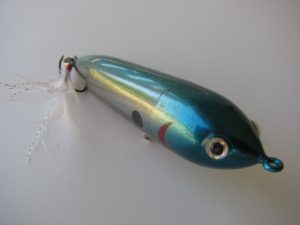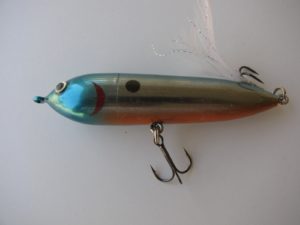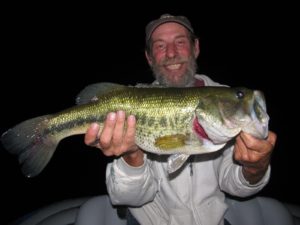 We have had the opportunity to test some unique baits over the years that usually are made by small companies that are either just starting out or do things in such a way that it makes it more difficult for them to mass produce their baits.
We have had the opportunity to test some unique baits over the years that usually are made by small companies that are either just starting out or do things in such a way that it makes it more difficult for them to mass produce their baits.
Last year we were reminded of a company that we had heard of about four years prior but hadn’t had the chance to acquire and test any of their baits. Well, we don’t often miss out twice so we did indeed pick up a couple of the lures in question for testing.
Boing Lures are currently producing two topwater plugs that are made in the USA, each hand painted by Dwain Batey at Baitworks, and both feature their unique “Boing†sound.
Boing lures also feature stainless steel hook eyes, large heavy duty split rings, Gamakatsu #4 black nickel hooks fore and aft with the rear hook sporting a hand tied feathered treatment. Boing went all in and constructed the plug of Lexan as opposed to cheaper plastic.
For this review, we are going to be focused on examining the Boinger. This is a topwater, walk the dog style that is 4†long and weighs .60oz
Unique In Several Ways
You’ll notice that this plug is something different simply by the looks. Strip away the paint schemes and you’re left with a smooth, cigar-shaped bait that doesn’t have the usual molded in details such as gill plates orscale patterns typical of today’s hard baits.
Even the seams are completely different. With most hard baits, you have two halves that are put together with the seam running the length of the body. On the Boing lures, the seam runs the circumference of the body close to the head.
If you look at a picture of these lures you will be able to find paint schemes that are fairly transparent. What you’ll notice is that there is a wire attached to the nose line tie on the inside of the bait that has a round weight on the end of it.
These are the components that makes the noise in this lure. It does not use multiple beads in designated chambers. It is the one bead, suspended on this wire that makes the distinctive sound when the bait is worked.
Boing Lures advertises it as, “audio attraction that eclipses all othersâ€. So does this one-of-a-kind sound generate more strikes than other spook style baits? And what is an appropriate way to describe that sound?
How About That Sound?
When the Boing is moved, you can hear it, but the real finesse of the sound is only audible when its close to your ear. It sounds like an old can of spray paint made of tin with a metal ball for the mixer.
It has an echo to it that sounds almost cartoonish. Similar to the “booiinngg†sound you might hear in an old episode of Looney Toons. I am absolutely dating myself with that reference!
Not withstanding, this is the closest description of the sound generated by the Boing lure that we’ve come up.
So now that we’ve gotten that our of the way the question becomes how’s the bait fish? After all, the bottom line with any lure is whether or not it draws strikes, right?
The Good Stuff
The Boing casts well even though it really isn’t all the heavy at .6oz. It’s in that range where you’ll want to use a relatively light line so that you don’t overpower the lure which could negatively affect its performance.
This plug does a good job of walking the dog. While it isn’t the easiest to get consistent and varied performance of its action, it isn’t the most difficult we’ve ever fished either.
One thing that we’ve noticed in our testing is that we allow the Boing to sit longer than we do with other walk the dog style baits. The reason for that is to allow the resonant sound to act as an attractant while the bait is motionless in the water. It does seem as though that echo is still going for a short period after you stop the bait.
Coincidentally, this is when we’ve gotten most of our strikes on this plug. Cast it out, let the ripples subside, give it a few quick jerks of the rod tip then kill it. Count a few seconds then repeat with an emphasis on the length of the pause.
Doing it this way provides the greatest opportunity for the sound to work as well as for the fish to track it down and go for the kill.
The strikes on the Boing have been on the aggressive side. We have had very few short strikes which in turn has resulted in an excellent hook up ratio with the sticky sharp trebles sealing the deal.
Our test baits have stood up quite well to repeated strikes from all sizes of fish from dinks to donkeys. The components have shown very little wear and the feathered rear trebles are still intact.
To the question of whether or not the Boing has resulted in a larger number of strikes, we can’t say that they have. Comparable numbers, definitely. Increased numbers, no. However, due to the excellent hook up ratio, the number of fish landed from those strikes have been a bit more.
The Boing lure is a bait that is designed with quality in mind. Everything from the components to the fact that each lure is hand painted and finished is a testament to the commitment this company has to produce high quality baits.
The Boing lures retail for about $25 per which is on the high end for this genre of baits but you certainly can’t argue that they are effective.
| Boing Lures Boinger | |
|---|---|
| Overall Rating | |
| A quality topwater plug with a unique sound | |
See ya’ on the water …


